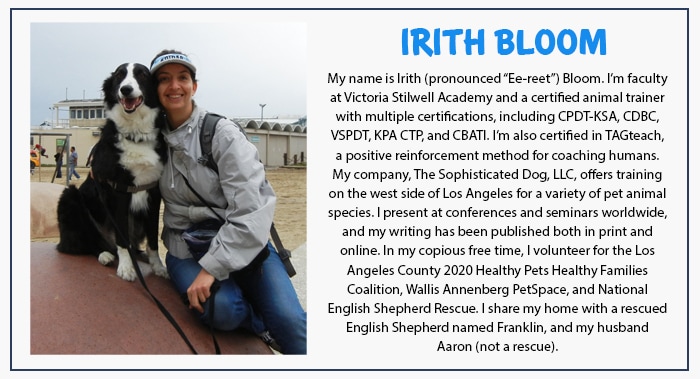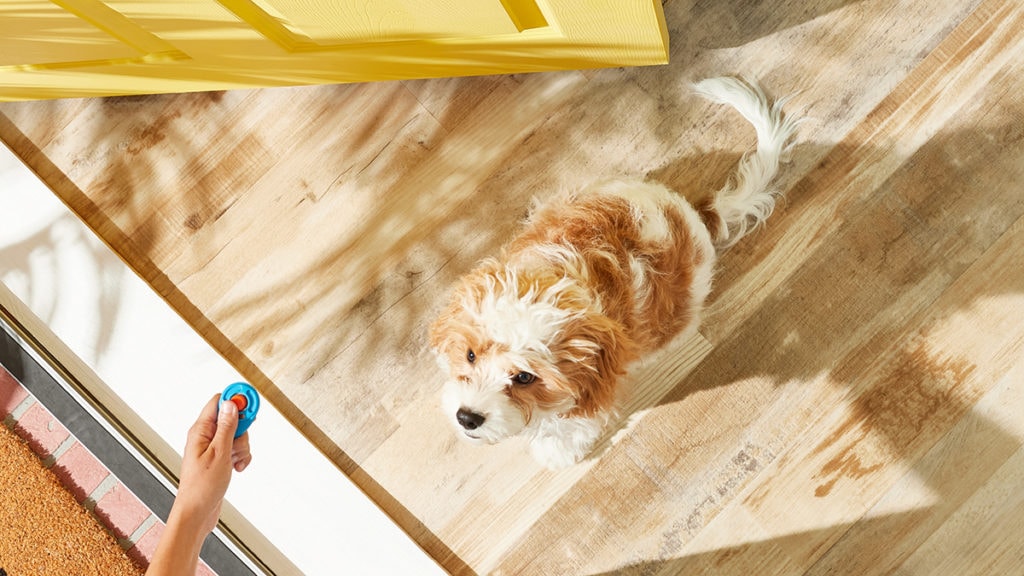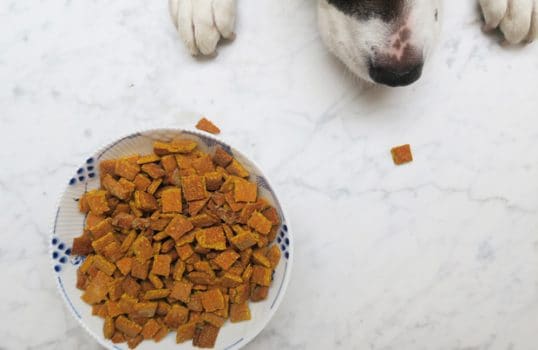Behavior chains are a hot topic among trainers who compete with their dogs in agility, freestyle heeling and other pet athletic sports. The use of long behavior chains is an advanced clicker training technique.
I usually don’t teach behavior chains to my dog training clients because most people who want to train their dogs are focused on individual behaviors, such as teaching your dog to sit. That said, behavior chains can be fun to practice and are a good way to reduce how much dog food you use in training. Let’s start by discussing the term “behavior chain.”
What Are Behavior Chains in Dog Training?
Behavior chains are a sequence of behaviors that happen one after another. An example is your pet going over an agility jump, then running through a tunnel, then doing weave poles, and so on.
At home, a behavior chain you can teach your dog is to retrieve an object; the pup must find the object, pick it up, carry it and bring it back to you. This would be a “fixed behavior chain,” because it involves a fixed set of behaviors done in a particular sequence.
When dog trainers talk about “behavior chains,” they often are referring to behavior chains with handler cues; several behaviors follow one after the other, but the specific behaviors and the order in which they are performed may vary. This will be our focus today.
What Does a Behavior Chain Look Like?
In fixed behavior chains and behavior chains with handler cues, parents or trainers offer a primary reinforcer, such as PureBites chicken breast freeze-dried dog treats, after the dog completes the last behavior in the chain. No primary reinforcers are offered between the chained behaviors; instead, each behavior is reinforced by the cue for the next behavior.
Let’s say you want your dog to come to you, then sit and finally lie down. Assuming you are using a Downtown Pet Supply training clicker and dog treats, working each behavior individually—instead of chaining the behaviors together—the sequence might look like this:
“Come” cue → dog comes to you → click and treat
“Sit” cue → dog sits → click and treat
“Down” cue → dog lies down → click and treat
You get three behaviors for three clicks and treats. Because the primary reinforcer, aka the treats, are given after each behavior, this is not a behavior chain.
If you chained the behaviors together, it would look like this:
“Come” cue → dog comes to you, “sit” cue → dog sits, “down” cue → dog lies down → click and treat
Because there is only one primary reinforcer— one treat—this is a behavior chain. You just got three behaviors for a single click and treat!
Keys to Successful Dog Training for Behavior Chains With Handler Cues
1. Each Behavior Must Have a Handler Cue
As the phrase “behaviors chains with handler cues” implies, each behavior must have a handler cue. If the behavior doesn’t have a distinct signal, such as a word or hand gesture, you can’t use it.
2. Each Behavior Needs a Strong History of Reinforcement
The most important point in successfully using behavior chains with handler cues is to make sure each behavior has a strong history of reinforcement. In other words, each behavior must have been rewarded by food or another primary reinforce, such as play with a well-loved toy, on numerous occasions.
One good way to ensure a behavior has a strong reinforcement history is to teach it through clicker training. That way, your dog earns a click and a treat each time he performs the behavior correctly. This also provides your pup with good associations with the behavior—assuming you’ve practiced it enough times.
3. Stick With Older Dog Training Cues
A behavior your dog just learned is not a good choice for use in a behavior chain because it may not have a strong enough history of reinforcement for positive associations. An inconsistently reinforced behavior, or one that sometimes leads to unpleasantness for the dog, also are not good choices for your behavior chain. For example, if you occasionally yell at your dog after you call him or you clip his nails when he comes to you, the “come” cue would be a poor choice for use in behavior chains.
4. Each Behavior Must Be Performed Fluently
Your dog must be comfortable enough with each cue to perform the behavior in a variety of situations and from a variety of positions. In these cases, clicker trainers call the dog “fluent.”
Let’s say you’ve taught your dog to sit on cue; are you confident he will sit when you give the “sit” cue, even if he is far away or in an odd position? If you cue “sit” and sometimes your dog sits, but other times he lies down or simply wanders away, the behavior is not fluent. In this case, spend more time working on the “sit” behavior individually before trying to use it in a behavior chain.
If your pet only knows two or three cues that well, limit your behavior chains to those behaviors. And feel free to rearrange their order. For example, you might ask your dog to come to you, then lie down, and then sit from the down to earn the click and treat. Or you could have your dog lie down at a distance, then sit up from the down, and then come to you to earn the click and treat.
4. Timing Is Everything
As you give your cues—”sit,” “down,” “come” in the above example—cue with the same timing as you would use during clicker training. So you might cue “sit” first, and then cue “come” just as your dog completes the sit.
Begin with two or three cued behaviors in a row before the click and treat. Gradually build up to more behaviors before the click and treat. It’s OK to repeat behaviors, such as “sit,” “down,” “spin,” and “sit.” If you want to add new behaviors to the chain, establish fluency with the new behavior first.
In time, you can do 10 or more behaviors in a row before clicking and treating! Even when you build up to that level, though, make sure some of your behavior chains are shorter and easier, to ensure you keep dog training fun for your friend.
Using behavior chains with cues is a great way to work your dog’s brain while reducing the number of treats you use in each clicker training session. If you follow the guidelines above, you and your dog will be behavior chain experts in no time!

Featured Image: via Chewy Studios
Share:











